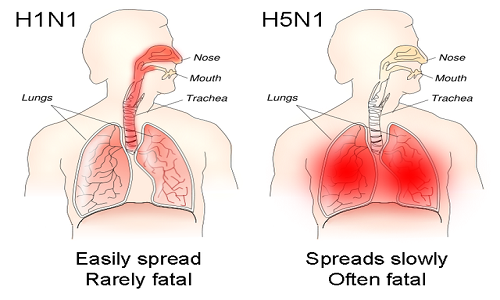Difference Between Flu And Stomach Flu
Influenza or commonly “flu” is a type of viral infection that is presented with symptoms like fatigue, fever and respiratory congestion. It is highly contagious and affects primarily the respiratory system. Flu is typically caused by influenza A viruses belonging to strains H3N2, H2N2, H5N1, H7N7, H1N2, H9N2, H7N2, H7N3, H10N7, H7N9 and HIN1, two types of influenza B viruses and rarely by one strain of influenza C virus. Influenza often mimics the symptoms of common cold and in severe cases may lead to pneumonia and septicaemia. Antibiotics are ineffective in treating influenza as because it is a viral disease, however influenza may be managed by vaccines and antiviral agents. The influenza viruses may inhibit the formation of Adrenocorticotropin hormone which results in decreased levels of cortisol. Since the immune system is not depressed, there is a formation of pro-inflammatory cytokines and chemokines that helps to combat the viral infection and is also responsible for the fever, headaches associated with influenza.
Stomach flu, on the other hand is a misnomer because it actually refers to gastroenteritis that can be caused by bacteria, viruses or protozoan parasites. Since viruses can also be a causative pathogen for gastroenteritis, the condition is referred as stomach flu. The common bacterial species involved are Escherichia Coli, Campylobacter sp., Shigella sp., and Salmonella sp. The viral strains involved are Norovirus, Adenovirus, Cytomegalovirus and Herpes simplex Virus. The gastroenteritis or irritation and inflammation of the stomach and small intestine are caused by corrosive foods, contaminated food and water, and through lactose intolerance. The microbes access the gastrointestinal tract through contaminated food and water. The lactose intolerance develops due to an inadequacy of lactase enzyme that digests dairy products. The symptoms include abdominal cramps, nausea, vomiting, stomach ache, diarrhoea and dehydration. Fever and swollen lymph glands may be also noted in some cases of gastroenteritis. Gastroenteritis may be treated with anti-bacterial, anti-protozoan and antiviral agents as per the situation. A comparison between flu and stomach flu is presented below:
| Flu | Stomach Flu | |
| Organ system affected | Respiratory tract both upper and lower | Gastrointestinal tract mainly stomach and ileum |
| Period of Illness | Prolonged beyond 3 days | Lasts from 1 to 3 days |
| Contagious | Highly contagious | Less contagious |
| Causative Pathogens | Exclusively viral | May be viral, bacterial or protozoan |
| Microbes Involved | Influenza A viruses belonging to strains H3N2, H2N2, H5N1, H7N7, H1N2, H9N2, H7N2, H7N3, H10N7, H7N9 and HIN1, two types of influenza B viruses and rarely by one strain of influenza C virus | Common bacterial species involved are Escherichia Coli, Campylobacter sp., Shigella sp., and Salmonella sp.The viral strains involved are Norovirus, Rotavirus, Adenovirus, Cytomegalovirus and Herpes simplex Virus |
| Incurred through | Sneezes, coughs and inhalation | Contaminated food and water, lactose intolerance |
| Symptoms | fatigue, fever, running nose(rhinitis) and respiratory congestion | Abdominal cramps, nausea, vomiting, stomach ache, Loss of appetite, diarrhoea and dehydration. |
| Overlapping disease symptoms | Common Cold | Nothing as such |
| Patho-physiology | Suppress ACTH and cortisol, leading to hyperactivity of immune system | Pathogens cause inflammation and due to super infection, immune system may be repressed |
| Management | Specific vaccination like trivalent or tetravalent flu vaccines that provides protection against influenza A and influenza B strains of viruses | No specific vaccination available as because the disease can be of bacterial and protozoan originHowever some vaccination is available against rotaviruses |
| Seasonality | Highly seasonal | Can occur anytime during a year |
| Complications | Heart failure, diabetes and asthma | Severe dehydration and hypovolemia |
| Susceptible Population | Pregnant women, Individuals infected with HIV, diabetics. | Unhygienic consumption of food and water |
| Prevention strategies | May not be prevented, however avoiding contact with affected persons may act as a precautionary measure | Proper sanitation and using UV radiated water for consumption |
- Difference Between “Heart attack” and “Cardiac arrest” - June 24, 2016
- Difference Between Connective Tissue and Epithelial Tissue - June 22, 2016
- Difference Between Migraine And Stroke - January 11, 2016
Search DifferenceBetween.net :
Leave a Response
References :
[0]Duben-Engelkirk, Paul G. Engelkirk, Janet (2011). Burton's microbiology for the health sciences (9th ed. ed.). Philadelphia: Wolters Kluwer Health/Lippincott Williams & Wilkins. p. 314.
[1]Jefferson T, Del Mar CB, Dooley L et al. (2011). "Physical interventions to interrupt or reduce the spread of respiratory viruses". Cochrane Database Syst Rev (7): CD00620
[2]Longo, Dan L. (2012). "187: Influenza". Harrison's principles of internal medicine.(18th ed. ed.). New York: McGraw-Hill.
[3]https://en.wikipedia.org/wiki/Influenza

